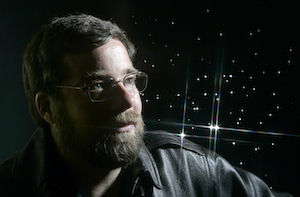by Scott Kardel
- Published: Saturday, April 19 2014 08:13
For all of human history the night sky has been a source of inspiration and wonder. Our nightly encounter with the stars has done much to influence art, philosophy, science and religion. Yet in the last century humanity has been increasingly lighting up the night and removing the stars from view.
It is difficult to calculate what the loss of the stars is doing to our sense of wonder or to know what great works of art we’ve lost, never having been inspired by the night sky. We do know that this problem, known as light pollution, is growing. Yet light pollution is a problem that is easily fixed and that it is the only form of pollution with solutions that actually save money.
The biggest obstacle in solving the problem is that many remain ignorant of how to effectively make use of light. All too often light at night is added without any thought given as to where the light needs to shine, how bright it needs to be or how long it needs to be on. As a result, lighting often is far brighter than it should be and shines into the sky all night long—even after it is no longer needed.
Amateur astronomers can help to end light pollution. The first step is to learn more about it. Thankfully, there’s a great opportunity to learn more in the form of International Dark Sky Week (IDSW). This year IDSW, a part of April’s Global Astronomy Month celebration, runs from April 20 – 26.
Many astronomers are surprised to learn that light pollution is a problem that extends far beyond astronomy. Light at night has a strong negative impact on the natural world. Harsh lighting can create glare that compromises vision and safety. Light at night can lead to sleep disorders and long-term health problems. Excessive or poorly directed light wastes energy. All of these are reasons, beyond our desire to see more stars, why light pollution should be fixed.
Head over to the IDA’s IDSW website to learn more about each of these. Each day during the week there will be an exploration of a different topic related to light pollution. The last day of the week will include the solutions to the problem.
Some of the main points about light pollution are also explored in the IDA’s short video called Losing the Dark. The video has been translated into many languages (Cantonese, French, German, Hebrew, Hindi, Japanese, Korean, Mandarin, Polish, Russian, Turkish and Spanish). All versions can be downloaded for free from IDA’s website. There are even versions of the video freely available for planetarium theaters. The IDA encourages people use the video to help raise awareness of the problems of light pollution.
IDSW is also a great time to help measure how much light pollution brightens the night sky. There’s no easier way to do that than to participate in the free citizen science program known as Globe at Night. Check out their website for the details on how you can contribute to our global knowledge of light pollution.
For over a quarter century the International Dark-Sky Association (IDA) has been calling attention to the problems of light pollution while working with advocates to help spread the word and with industry to encourage them to make “dark-sky friendly” lighting fixtures. Today, the IDA is also advocating for improved controls of lighting to not only ensure that it points downward, but also has the ability to be dimmed or extinguished when it is no longer needed.
By joining the cause, you can help to restore the night sky for many and keep the stars as a source of inspiration for generations to come.
###
 Scott Kardel is the managing director for the International-Dark-Sky Association, a non-profit dedicated to preserving and protecting the nighttime environment. Scott has a BS in physical science / secondary education from Northern Arizona University and a Master’s Degree in astronomy from the University of Arizona. He has worked as assistant director for the Lake Afton Public Observatory in Wichita, Kansas and as the public affairs coordinator for Palomar Observatory. There he directed their public outreach programs and was the observatory’s representative on light pollution issues. He has been with the International Dark-Sky Association since August, 2011.
Scott Kardel is the managing director for the International-Dark-Sky Association, a non-profit dedicated to preserving and protecting the nighttime environment. Scott has a BS in physical science / secondary education from Northern Arizona University and a Master’s Degree in astronomy from the University of Arizona. He has worked as assistant director for the Lake Afton Public Observatory in Wichita, Kansas and as the public affairs coordinator for Palomar Observatory. There he directed their public outreach programs and was the observatory’s representative on light pollution issues. He has been with the International Dark-Sky Association since August, 2011.








Comments